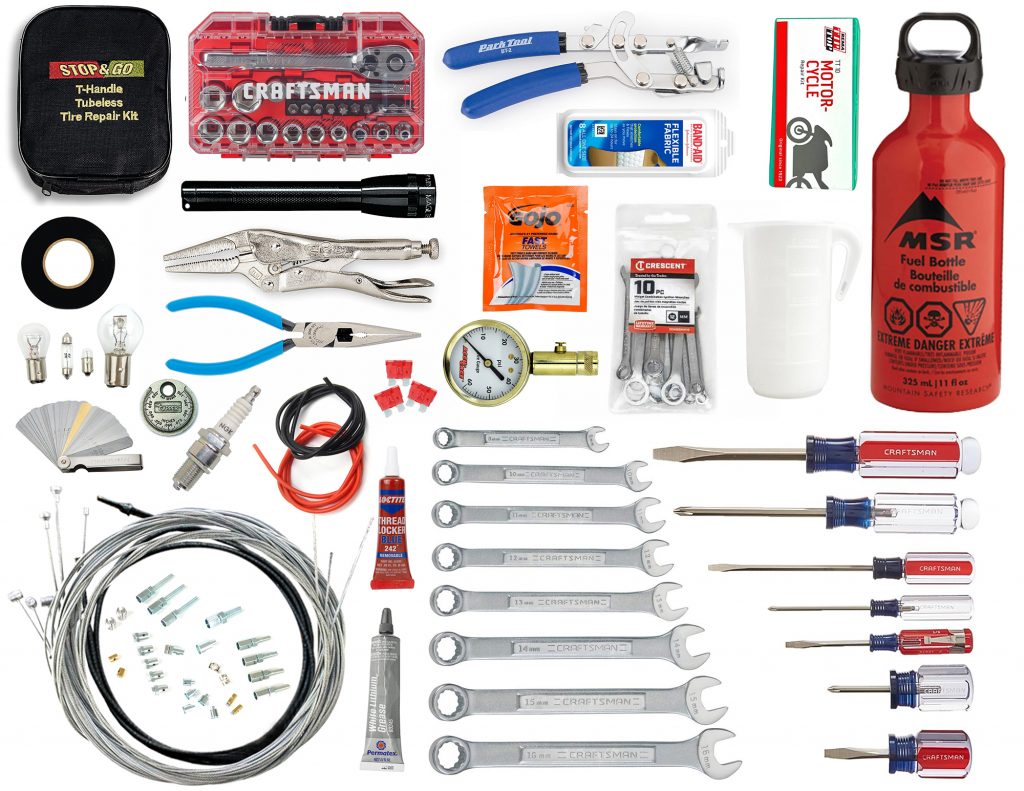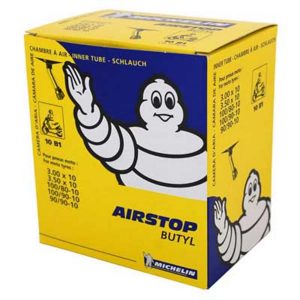Tools and spares to carry with you on your scooter
If you’ve got a late-model scooter, ride it regularly, and take it to the dealer for regular service, maybe you’ll never need to think about what’s going on inside that shiny bubble between you and the rear wheel. If something stops working, you can call Roadside Assistance, take an Uber home, and get on with your life.
But sometimes that’s not an option. You may have more time than money, or depend on your scooter for daily transportation. You may simply have a desire to know what makes your scooter tick. Eventually for some reason or other, you’re going to need to get in there and adjust or repair something. You’ll need to be prepared with the right tools.

We can work up to a garage full of pneumatic tools and arcane factory tools someday, but today, let’s focus on the tools and spares that all scooterists should carry on their bike at all times.
The Essentials
If you do nothing else, do this:

- Look at the TOOL KIT that came with your scooter. You’ll find that even if you paid $10,000 for your scooter, the enclosed tool kit is made out of Play-Doh, and nearly useless. These tools permanently defile any fastener they touch. So right away, replace everything in that tool kit with a quality version of the same tool, aside from maybe the plug wrench and the shock adjustment tool, they’ll work fine in a pinch. (If you ever resell your scooter, the buyer will be impressed by that never-opened tool kit.)
Alternately, some scooter shops sell assembled UPGRADED TOOL KITS for certain popular models. - An extra SPARK PLUG (or two) of the proper type.
- A spark plug GAPPING TOOL (or a small set of FEELER GAUGES).
- Hard copies of your REGISTRATION (not title!), INSURANCE card, and ROADSIDE ASSISTANCE info.
- Always carry CASH, CREDIT/DEBIT CARDS, ID, and your CELL PHONE (on your person, not in your bike)
- DRINKING WATER, your PHONE CHARGER, and SUNSCREEN are also essential
If you have a modern scooter and no intention of ever messing around with your scooter, that’s probably all you really need, but in our years of scootering, we’ve found the following items very useful on the road:
- ELECTRICAL TAPE (wrap a few feet around a pen or wrench to save space).
- Various ZIP TIES and BUNGEES or a BUNGEE NET (not pictured).
- A couple feet of ROPE or STRING and/or BALING WIRE (not pictured, useful if you need to tie a loose body panel or exhaust in place).
- A SHOP RAG or MICROFIBER TOWEL, and MECHANIC GLOVES (not pictured).
- A tiny FLASHLIGHT with good batteries (Yes, there’s one on your phone but you might need the phone for other things).
- Packets of HAND CLEANER or WIPES.
- A tiny FIRST AID KIT, or at least a couple Band-Aids.
- A tiny tube of GREASE.
- A small square of medium-grit SANDPAPER or an EMERY BOARD (not pictured).
If you have an older scooter and/or will be travelling far from civilization, you’ll probably want more tools. Just about all scooters are metric, but fastener types and sizes vary by manufacturer. Look at your scooter (and the internet) to see what sizes and types you’re most likely to need for tasks like tightening your lug nuts, changing bulbs, adjusting cables, tightening or adjusting mirrors/windscreen, etc. Some of those will be in your “factory” toolkit, but others won’t. It’s not necessary to carry a full set, just what you’re likely to need for the fasteners on your scooter.
- SCREWDRIVERS (sizes and types as necessary*) and (if necessary) TORX and ALLEN DRIVERS. Maybe a universal handle with the tips you’re likely to need, though i find the tips get lost easily and sometimes you want more than one at a time.
* note that there is secret and maddening third type of screw head, found on older Japanese motorcycles and scooters, called “JIS.” it looks exactly like Phillips, but it’s slightly different, and very likely to strip if you use a Phillips screwdriver. (There’s sometimes a tiny dot scribed next to the cross to identify it.) You can find JIS screwdrivers on eBay or Amazon.
- WRENCHES: I’d suggest one small high-quality ADJUSTABLE WRENCH (not pictured) and a few METRIC COMBINATION WRENCHES in the sizes you need. METRIC IGNITION WRENCHES are smaller and narrower… and super useful for cables and other tight spaces.
- A METRIC SOCKET SET may be overkill but it’s nice to have, preferably a 1/4” drive ratchet with sockets in the range you need.
- Small NEEDLE NOSE PLIERS and/or NEEDLE-NOSE VISE GRIPS.
- A tiny tube/packet of THREAD LOCK (e.g. Loctite blue);
- Spare BULBS, carefully wrapped safely
- Spare FUSES, if applicable.
- If you have a vintage scooter, you might also want a bit of threaded, insulated WIRE, the same gauge as the wiring in your scooter, and a handful of WIRE CONNECTORS (not pictured), the type(s) used in your bike. Wire cutters, crimpers, solder, and heat-shrink are essential for a quality job, but probably more than you want to carry for roadside repairs, you can fix it better when you get home.
For tire repairs:

- If your scooter is blessed with a SPARE TIRE, make sure it’s at the correct pressure, in good condition, and you know how to replace it.
- If you don’t have a spare, but have a scooter with easily-removed split-rim wheels, pack an INNER TUBE (right), or at the very least a PATCH KIT.
- If you have modern tubeless tires, an EMERGENCY TIRE REPAIR KIT can usually get you to the next stop.
- Also carry a TIRE PRESSURE GAUGE that’s optimized for your pressure range. The ones at gas stations are rarely accurate. And carry QUARTERS for the air machine.
If your scooter is of the 2-stroke persuasion:
- Fill the reservoir regularly, but also carry a bottle of 2-STROKE OIL (not pictured) for emergencies and long trips.
- If your scooter requires 2-stroke oil to be mixed directly in the tank, be sure to carry a MEASURING CUP or other metering device (we recommend this one!)
Mandatory for vintage scooters (probably overkill for modern scooters):
- A full set of spare inner CABLES (front/rear brake, throttle, clutch, and shifters)
- cable ADJUSTERS, TOP HATS, KNARPS, and any necessary tools and lubricants. (the Treatland “Knarp Party” has saved me multiple times). A FOURTH HAND TOOL is nice if you have space, but your vise grips will do in a pinch (no pun intended).
For long trips:
- a small CAMPING FUEL BOTTLE full of fresh gasoline.
This list should cover most riders’ needs. It seems like a lot, but it should fit into a bag or two in your glovebox, or under your seat. A ZIPPERED CANVAS TOOL POUCH or a couple vinyl bank deposit bags are great, they conform to tight spaces and are less likely to rattle than a hard case.
If you know your bike’s having some sort of issue, or that certain parts are near the end of their life, repair or replace them in the garage, before they become a bigger problem by the side of the road. For touring (days or weeks of riding long distances), you’ll want to consider what you need for maintenance and repair and either bring it all, or ship it ahead to your waypoints. Also note that some expanded tool kits like this one for the Vespa GTS from SIP include specific service tools that you needn’t carry every day, but might save the day on a multi-day excursion.
TOOLS FOR YOUR PHONE:
There’s plenty of info available online, but it’s smart to download your scooter’s manuals, specs, and wiring diagrams to your phone so you can access them when you’re out of service range, or trying to save battery power. Also keep contact info for Roadside Assistance and a list of motorcycle tow companies in your area. If you do perform any roadside repairs, take before-and-after photos as a reminder to re-do the job more carefully once you get home. A 2-stroke oil mixing calculator is handy to have on your phone, too, in case you lose your metering cup
IT TAKES A VILLAGE
Being well-prepared is comforting, but everyone can’t always be prepared for everything. Sometimes you’ll need to borrow a tool or spare part (or $5 for gas) from another rider in your group or a stranger passing by. Most riders are happy to help… the first time. If you’re the recipient of someone’s kindness, thank them profusely (dinner, a movie, and a replacement for the borrowed tool, part, or fluid shipped to their home a few days later should suffice). And remember the time someone bailed you out when you see a fellow rider struggling! Do unto others as yadda yadda yadda…
DISSENTING OPINIONS
VCOA member and motorcyclist Phil P. argues that no one should be carrying too much gear. He recommends careful research on forums to find the bare minimum tools necessary, and to consider bicycle toolkits for their smaller size/weight. He also suggested researching your specific model for bespoke upgraded toolkits. I agree that’s all good advice, especially if you’re riding a reliable and common modern scooter, but with a vintage bike, it’s better to err on the side of preparedness.
VCOA member Jason E. rides a BMW maxiscooter, and thus has far more storage space than most scooters, so he also carries a BATTERY CHARGER and an ELECTRIC TIRE PUMP Nice, if you have the space! (fun historical note: some vintage scooters were originally outfitted with a manual tire pump!) Jason also cites the experience of our friend who left for a cross-country ride knowing his drive belt was overdue for change (on an older model where drive belts aren’t easy to come by) and his trip went downhill fast…
Above all, follow your maintenance schedule, and maintain your bike properly, and hopefully you won’t need to break out the tools very often!

